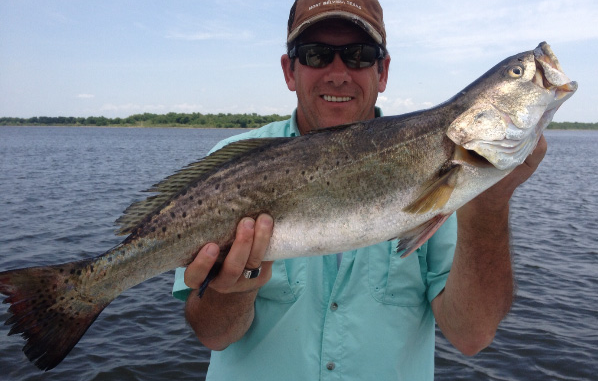
Preliminary data indicate no problems with speckled trout populations, LDWF biologist says during CCA-called meeting
Work on the soon-to-be-completed statewide speckled trout stock assessment indicates the species is in good shape despite recent concerns from some coastal anglers, a Louisiana Department of Wildlife and Fisheries biologist told a crowd of almost 200 people last night in Lake Charles.
“In every case, what we’re trying to do is look at what has been the past status of the stock. What is the current status of the stock?” LDWF’s Harry Blanchet said. “Is the stock producing recruits on an annual basis to the fishery? That’s the bottom line.
“In all cases, we’re seeing the stock is well capable of reproducing itself.”
The last statewide stock assessment was completed in 2010, and biologists are in the last stages of updating it with new data collected by LDWF biologists.
The standing-room-only meeting was called to address various issues facing Big Lake, ranging from the effects of dredging projects in the Ship Channel to the current status of the speckled trout fishery.
The meeting, which stretched almost four hours, was sponsored by the Lake Charles Chapter of the Coastal Conservation Association and took place in Prien Lake Park.
Blanchet, biologist director for marine fisheries with the LDWF, said the firestorm created early last month about the possibility of reducing the speckled trout limit on Big Lake was unfortunate.
“I guess the best I can say on this is that, at least from my perspective, a lot of this has been blown out of proportion. There was a question by a commissioner,” Blanchet said. “Primarily the concern came because Texas at the time was considering reducing its creel limit on spotted sea trout.
“Talking with the folks at Texas Parks and Wildlife, they were going to be reducing down to five fish-per-person essentially from Matagorda Bay south. So the Galveston Bay, Sabine Lake area is going to remain at their current regulations level. But the concern was with that change in limits, was there a need for us to be looking at a change in limits.”
Will Drost, who requested the speckled trout information, abruptly resigned from the Louisiana Wildlife and Fisheries Commission in the first week of June. He did not attend the June 5 Commission meeting when the agenda item regarding trout came up for discussion.
Blanchet said the LDWF is currently working on a statewide stock assessment for speckled trout, and would provide that information to the Commission for their consideration as it relates to Big Lake later this fall.
Unless some unexpected problem is discovered as that assessment winds down, Blanchet said any regulations changes would be base more on social concerns rather than scientific need.
“… (A)t that point it becomes a decision for decision makers in terms of how you want to allocate the resource amongst the various user groups,” he said. “The creel limit is one method of controlling harvest. Size limits are one method of controlling harvest. Closed seasons is another method of controlling harvest. When we are looking at harvest of a species we’re basically looking at how many fish can you take out of the population and have that population maintain itself.
“Now, how you want to slice that pie in terms of size limits, creel limits and so forth — those types of decision get made by the Commission.”
He said biologists would simply give commissioners information on how different approaches would affect trout populations.
“… (W)e would essentially provide information in terms of what the various options would be and what the impacts of those would be, just as several years ago when the 15-fish limit came (to Southewest Louisiana),” Blanchet said. “We provided information that said, ‘This is going to be our estimate of the impact.’
“We’re not out trying to do something beyond that.”
CCA Louisiana Executive Director David Cresson said he was pleased with the turnout, as well as the information presented at the meeting.
“Our goal here was to get as much information out to the anglers and create a pathway of communication between the anglers and the government agencies that control these different issues that (anglers) have concerns with,” Cresson said. “I certainly think we accomplished that. We committed early on that we wouldn’t leave until everybody’s questions were answered.”
In addition to the speckled trout discussion, attendees heard from the U.S. Army Corps of Engineers on dredging projects in the Ship Channel; representatives from the Coastal Protection and Restoration Authority on the operation of the lake’s five weirs; and Patrick Banks, an LDWF biologist who discussed the status of oyster reefs and oyster production in the lake.
“We knew we couldn’t come up with any solutions tonight,” Cresson said. “But the first step in creating any solution is getting all the information, and giving people ways to get more information moving forward.”


